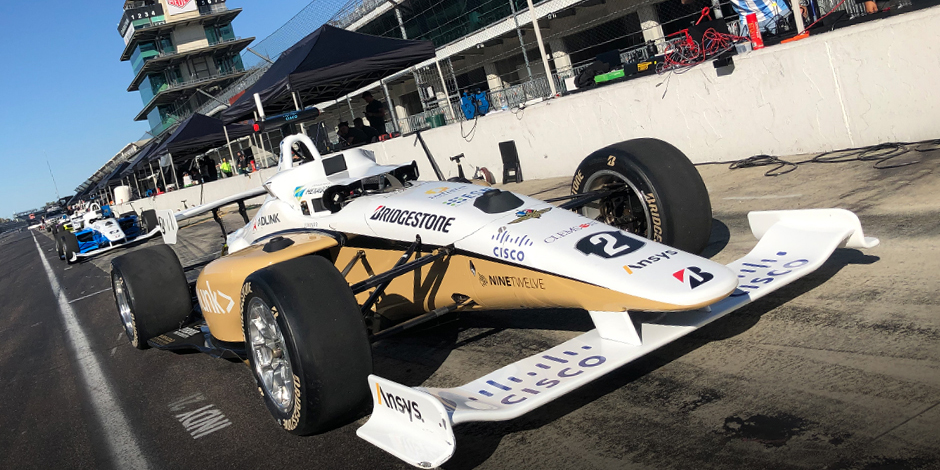
Indy Autonomous Challenge To Expand Tech Boundaries Saturday at IMS
October 21, 2021 | By Curt Cavin
The first autonomous race car competition in the 112-year history of Indianapolis Motor Speedway, where so much automotive ingenuity has debuted, will be staged Saturday with the Indy Autonomous Challenge Powered by Cisco.
Nine teams representing 21 global universities will have cars driving around the iconic oval track, with four finalists vying for a $1 million prize offered through a grant from the Indianapolis-based Lilly Endowment Inc.
While one team will ultimately be declared the winner, the technological advancements in the autonomous pursuit and the hundreds of students who have engaged in this two-year experience should be the benefactors.
The collaboration is illustrated by Purdue University’s Black & Gold Autonomous Racing, which features graduate students and professors from the West Lafayette, Indiana, campus that have pushed the boundaries with counterparts from IUPUI, the U.S. Military Academy at West Point and universities in India and Colombia. Through various online interactions, global bonds have developed that figure to lead to a shared commitment to autonomous development.
Auburn University, which has Autonomous Tiger Racing as one of the finalists, is using the IAC and Dallara’s modified Indy Lights chassis as featured elements to its new autonomous vehicle research facility attached to a test track. West Point has engaged its Robotics Research Center. The prize money will be used to advance the education and research missions of the winning universities.
“We’re excited that our students have the opportunity to invent and lead new paths in the autonomous industry on a global stage that is the Indianapolis Motor Speedway, working with other students from around the world, pushing the boundaries of technology,” said Christopher B. Roberts, dean of Auburn University’s Ginn College of Engineering. “It is inspiring and will continue to shape the high-level research we conduct here at Auburn.”
Live streaming will begin at 1 p.m. (ET) and can be viewed directly from the IAC website (www.indyautonomouschallenge.com) and on Twitch at @IndyAChallenge. Additionally, an estimated 1,500 high school students excelling in Science, Technology, Engineering and Math (STEM) programs will be in attendance, and they likely will be inspired by the effort. The event is open to fans via the IAC’s website.
Organized by Energy Systems Network and IMS, the goal of the IAC is to advance technology that can speed the commercialization of fully autonomous vehicles and deployments of advanced driver-assistance systems. Ideally, these enhancements lead to increased safety and performance in motorsports, as well as benefitting all modes of commercial transportation.
Just as racing development often leads to innovations used in the passenger car industry, the high speeds and handling challenges this endeavor offers is an ideal proving ground for autonomous mobility. The specific goal here is to have these cars pass each other at speeds in excess of 100 mph. It’s a challenge like few others.
The cars which the teams will keep are equipped with custom-sensor packages that electronically feed data in specific intervals to the computers guiding them. A lag in feedback could be the difference between trusting the received information or forcing an emergency shutdown. The third potential outcome – wall contact -- is expensive and detrimental to future development as teams like Auburn’s plan to use their car for additional endeavors in the years to come.
Teams have undergone dozens of live testing days at Lucas Oil Raceway and IMS. For a variety of reasons, including a delayed supply chain amid this challenging pandemic, many of the key advancements have come in recent weeks. For those reasons, it’s possible this isn’t the last such event to be held.
Michael Saxon, a robotics expert spearheading Purdue’s effort, said the intricacies of driving a car without an onboard driver are vast.
“At the end of the day (traditional race teams) put a capable car in the hands of the driver,” Saxon said. “Yes, some teams are able to eke out more speed than others and there are some differences in the drivers, of course. But ultimately, you expect the car to come back in one piece.”
The same is not a guarantee for autonomous cars, particularly at these projected speeds on an oval racetrack lined with barriers. If that hasn’t been challenging enough, there have been numerous software and hardware elements to manage.
Add it up, and this is a remarkable pursuit.
“You think about what’s happening,” said Saxon, an Anderson, Indiana, native and West Point graduate who spent 23 years in active duty with the U.S. Army, including 15 months in Afghanistan. “You’ve got cameras, GPS sensors, light (rays), they’re all taking this data in. There’s a time delay getting the data in the first place, then you throw that on top of getting the data routed to the appropriate place, get the computing done on the car, being able to take that computing and apply algorithms to it and get (the computer) to make the appropriate decisions, then send the information back out to (the car) to apply the brake pedal, accelerator, steering angle or whatever ...
“You get one little hiccup in the middle of that, and it’s not too long before you’re in the wall. It’s tough, for sure.”
The Boston Dynamics’ agile mobile robot, SPOT, will serve as the official flag waver for the competition.
The day also includes an invitation-only Autonomous Innovation Summit hosted by the Indiana Economic Development Corporation and co-sponsored by Luminar. Indiana Governor Eric J. Holcomb, U.S. Senator Todd Young and U.S. Deputy Secretary of Commerce Don Graves are among the summit’s speakers and panelists.